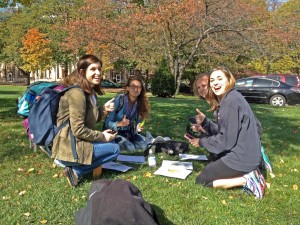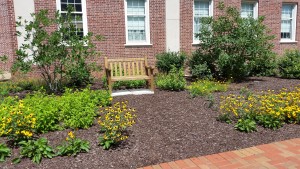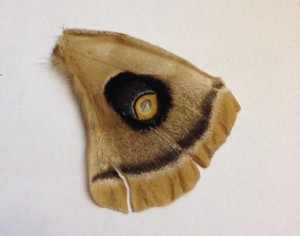The Metzgar sports complex is mostly surrounded by corn fields. The corn has long died and is now drying out slowly. If you move along the cross country course, away from Metzgar and towards the intramural fields, you find yourself running through a corridor with corn towering high on your left and beans cowering to the right. Even though the beans are very low to the ground, they still had a significant presence that I only noticed today when they had been removed this weekend by however owns the land. The barren fields opened up the area and I could see directly to the suburban houses on the road several hundred meters away. Before the harvest, there is some feeling of being enclosed by the fields, but once all of the crops have been removed, there is nothing there to cut the view or the wind, literally make Metzgar feel colder and less inviting of a place. Even though this “nature” is man made and cultivated, it still has comforting affects when it is present.
Category Archives: Gardens
Leaf-snapping
Passages of Note, Tallamy
“I had witnessed the local extinction of a thriving community of animals, sacrificed so that my neighbors-to-be could have an expansive lawn” (22).
Tallamy in this passage is noting his time growing up in Berkeley Heights, New Jersey, which happens to border my hometown of Chatham. I am all too familiar with this phenomena of bulldozing lawns with new homeownership, leveling lawns, and installing irrigation systems that are totally blind towards local fauna, plantings, animals, and habitats. But, what I find curious of the author is that Tallamy does not mention what also borders both of our towns, the Great Swamp Wildlife Refuge. This massive expanse of land was supposed to be the site of Newark Airport before local lobbying efforts stopped this from occurring, but the land has incredible biodiversity and expansive ecosystems and is about 5 minutes from Tallamy’s home. Perhaps it simply did not fit his argument to include this in his piece, but I do want to give where I am from some credit in the environmental sustainability fight.
“We did not systematically start at one end of the continent and wipe out everything as we proceeded. Instead, we left islands of suitable habitat in which most of the plants and animals that survive today found refuge. At first, these habitat patches were relatively large, but today there are miniscule, far too small to sustain populations of most living things for very long” (25).
This passage strikes me in two different capacities because I feel as if the concept of manifest destiny would not see settlers leaving pockets of land alone for nature to maintain all by itself. I was always led to believe that manifest destiny was a tidal wave, all-encompassing, taking up everything in its path and leaving nothing for those who were late to the party. Although, as I read on in this quote, I understood how these small islands were swept up after the gaze of manifest destiny missed them on the first pass. It is almost like man is making up for lost time by chiseling away at these small islands, taking more and more from the already tiny parcels of land that were left unmolested. Checking for gaps it seems like, almost as if humankind was saying “Did we miss a spot?”
Gardens to National Parks
“We can no longer hope to coexist with other animals if we continue to wage war on their homes and food supplies. This simple tenet provides an imperative, particularly for the bird and butterfly lovers among us, to fight invasive aliens as if it really matters and to reevaluate our centuries-old love affair with alien ornamentals” (Tallamy 14)
This passage was intriguing because of the importance it places on returning to planting native species. Gardeners love when their garden looks the most beautiful and attracts the most attention but what does that even mean if we are destroying the livelihood of the pollinators that sustain the gardens? I really like the metaphor here about “waging war”. We are slowly destroying the habitats of the most important parts of our ecosystems and food chains when we bring in foreign plants. This made me think, does it even matter that we preserve large masses of land (via national parks) to protect endangered species if in our backyards we have been destroying the ecosystem building blocks that sustain the park wildlife?
Protect Nature
After class today, I walked to Lower to grab some lunch, and ended up walking past the circle between Farinon and Pardee. As I was walking towards the street, I noticed some chalk marks on the ground surrounding the flower bed in the middle of the circle.
“PROTECT NATURE”
“DONT CUT THE FLOWER BED”
I thought it was interesting how such a small part of our campus, seemingly planted for aesthetic purposes, had a group of people advocating on its behalf. I would be curious to see what group on campus was responsible for trying to allow the natural growth cycles. Honestly, I did not take sufficient time to stop and see what kind of plantings/flowers were there, but I plan on during the next few days to stop by and see the type of plantings that are there. Why are they cut? Why are students trying to protect them? Is it one of the gardens around campus, similar to the one outside of Acopian that was pointed out to us the first day of class, that is indigenous to the region and aids pollinators? I am curious to look further into the matter, because if you do not take ample time to stop and actually look, you may never realize that there is an issue happening right in front of you.
Patterns in Nature
My mineralogy class challenged me to notice patterns in nature, such that they might represent forms of symmetry or unit meshes. This assignment aligned nicely with the fact that this course has also challenged me to actually take the time to see the world around me. One interesting example I noticed was the plant pictured below. It is imperfect, but it still shows signs of a pattern, repeated around the center of the plant and also down its stem. The leaves extend from the stem in groups of two or four at different levels all the way down. I stood around the plot just staring at the plants for a few minutes, as this odd pattern genuinely intrigued me. Of all the plants in the plot, I found this one most interesting.
citizen science
Russell’s book got me thinking about who is it that is doing citizen-science, since much of science is still dominated by white males, and to a lesser extent white females. It would seem that a positive attribute of citizen science is that it should remove most of the academic/economic/social (i.e. college degree) obstacles to participation in natural science, and thereby possibly appeal to folks from all walks of life. Indeed I did find several references to this while cruising the internet looking at citizen-science projects. This Hudson River Eel Project sounds particularly cool to me (cooler than tiger beetles). Here is a NYTimes op-ed about the project – well-worth a read.
In related matters, the other evening I saw entomologist Doug Tallamy (author of “Bringing Nature Home“, excerpts of which we will read later) speak about the ecological impacts of non-native plants in our home landscapes. Much of his data has been generated on his own 10-acre property, and he mentioned that he runs a citizen-science project, where people submit pictures of birds with insects in their bills, and he identifies the insects. It turns out that caterpillars (rich in protein, fats, and carotenoids) are really important in the diet of songbirds during the nesting season, and if there are no native trees and shrubs, there are very few caterpillars to be had, and thus few birds. Sounds like another version of Silent Spring? Here’s a description of his project.
Collaborative Nature
Day One of class and I already found myself enjoying a ramble around campus. The ramble allowed me to view sites that I pass daily with a deeper appreciation, truly experiencing the everyday nature. The Pollinator Garden visit was particularly poignant as my own personal project and as an example of collaborative nature.
Collaborative Nature features elements both natural and constructed that function together in harmony. In this particular example of the Pollinator Garden, the constructed element exists in the fact that the garden itself was a project organized and planted in a particular manner and location. The natural element remains the fact that these plants were all grown from seed and have been thriving in their new outdoor environment.
The intersection of such natural and constructed elements creates a spot of particular beauty for myself and others to enjoy. The picture below illustrates how the garden is flourishing, as it has developed its own strength from seed and from the resilience of its creators.
remains of a nocturnal visitor
My kids found this lying on our flagstones early this summer. It is large (more than 2 inches across), very light, somewhat furry, and beautifully marked. Interesting enough to spark some family curiosity. We dug around a bit on the internet, and discovered that it was the hindwing of a Polyphemus moth.
And some related interesting facts:
silk moth decline?
why eyespots?
I also found out that any caterpillars feeding on tree leaves (i.e. many butterfly and moth caterpillars like that of the Polyphemus) are killed when the “organic” pesticide Btk is sprayed to control gypsy moths. Gypsy moth is an invasive species from Britain that was introduced with the intent to develop an American silkworm industry. Now it is a big nuisance, periodically causing mass defoliation of eastern forests. Next year is apparently going to be a big year for damage in eastern PA
Here is a nice animation of the spread of the gypsy moth west and south from Massachusetts in the 20th century.



